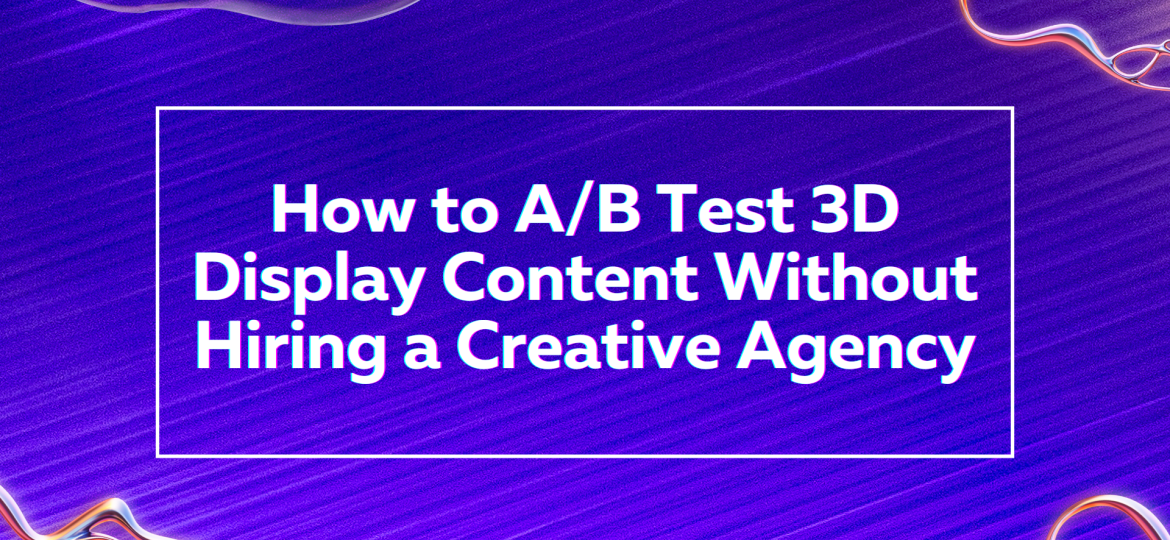How to A/B Test 3D Display Content Without Hiring a Creative Agency
How to A/B Test 3D Display Content Without Hiring a Creative Agency
A/B testing 3D display content means creating two versions of a visual setup to see which performs better. It could be for a retail shelf, pop-up booth, or interactive in-store screen. Why does it matter? Because it directly affects customer engagement, sales, and how well your display connects with viewers. You don’t need a creative agency to run these tests. With the right steps, you can test and optimize displays yourself using your existing team and simple tools.
H2: Steps to A/B Test Your 3D Display Content on Your Own
Step 1: Set a Clear Goal for the Test
Start by deciding exactly what you want to learn from the test. Are you trying to improve dwell time, increase QR code scans, or drive more in-store purchases? Choose one measurable goal, so your results stay focused. Without a specific metric, it becomes difficult to know what success looks like. A clear objective sets the stage for the rest of your test.
Step 2: Choose One Variable at a Time
A/B testing works best when only one thing changes at a time. For 3D displays, this could be the angle of the product, headline wording, lighting, animation speed, or texture. Avoid testing multiple elements together. If too many things change at once, you won’t know what caused the difference in performance. Isolate a single variable for clean, usable data.
Step 3: Prepare Two Distinct Versions
Now create two display versions: Version A and Version B. They should both look professional and finished, but must differ clearly in the element you’re testing. For example, if you’re testing lighting, make sure that’s the only difference—don’t also change the headline or color. Keep both options balanced so the test stays fair and focused.
Step 4: Split Your Audience or Time Period
Run Version A in one store location and Version B in another, or test them in the same place but during different weeks. The key is to keep the conditions as similar as possible. If one version is tested during a busy weekend and the other during a quiet weekday, results will be skewed. A fair test means comparing apples to apples.
Step 5: Track Performance Metrics
Choose KPIs that align with your goal. These could include dwell time, product interaction, QR code scans, changes in foot traffic, or actual sales. Tools can be as simple as tally sheets or as advanced as heat-mapping sensors. Even casual observation works if done consistently. Just make sure you collect enough data to draw valid conclusions.
Step 6: Analyze Results and Make Data-Backed Decisions
Once both versions have been tested, compare results without bias. Don’t go with your gut; go with what the data says. The version that performs better on your chosen metric wins. Keep a record of your findings to help guide future tests. Over time, these small wins compound into big improvements in display effectiveness.
Quick Tips for Better DIY A/B Testing
Run tests during high-traffic periods
The more people see your display, the quicker you’ll get meaningful data. Choose busy times like weekends, holidays, or promotional periods to test. This speeds up learning and helps you make faster decisions.
Let each test run long enough
Don’t rush the process. For accurate results, keep each version active for at least one full week. Shorter tests may give misleading data due to daily foot traffic fluctuations or temporary events.
Repeat your tests regularly
Customer behavior evolves, so what works now may not work later. Run new A/B tests every few months to stay aligned with shifting preferences and seasonal patterns. This ensures your displays stay fresh and relevant.
Conclusion
You don’t need an agency to A/B test 3D display content. As long as you test one variable at a time, track performance metrics, and make decisions based on real results, you can optimize your displays with confidence. Regular testing helps improve retail display optimization, split testing display visuals, and customer engagement tracking. When you’re ready to take your A/B testing to the next level with immersive visuals, Creativ Buzz can help you craft display content that truly converts.
Frequently Asked Questions
What is A/B testing for 3D displays?
A method of comparing two versions of 3D display content to see which performs better, based on set metrics like engagement or sales.
How can I measure the success of a 3D display test without special tools?
You can track sales changes, foot traffic counts, or customer interactions manually to gauge performance.
Do I need professional design skills to A/B test display content?
No. Focus on testing one element at a time using existing assets or free design tools.




